Bravos and Boos for 2016
It’s been another good year for San Diego Story. We walked away with the title “Best Entertainment Website” for the second year running, and our staff picked up eight awards total at the San Diego Press Club’s annual banquet. Classical music critic Ken Herman led the way with two Press Club awards, so he gets the honor of leading our 2016 round-up of San Diego’s music, dance, and theatre scenes. We asked each of our writers to cast their thoughts as “bravos” and “boos.” As you’ll see, some of them found it easier to do than others.
Be that as it may, we proudly present essays by Ken Herman, Kris Eitland, Bill Eadie, David Dixon, Martin Jones Westlin, and Welton Jones.
Ken Herman on Classical Music
Bravos
Several of the most exciting performances of 2016 were brought to San Diego by international virtuosos, notably solo piano recitals by Daniil Trifonov (February 28) and Hélène Grimaud (December 1), both presented by the La Jolla Music Society. The young Russian superstar Trifonov passionately dispatched some of the most challenging works of the piano repertory with breathtaking prowess, including the mighty J.S. Bach Chaconne from his D Minor Violin Parita arranged for the piano—left hand only—by Johannes Brahms.
Fueled by the French virtuoso’s astounding technique and daring musical insights, Grimaud’s musical itinerary included eight shorter works related to the theme of water from both expected and surprising composers: Debussy and Ravel (the usual suspects), as well as outsiders such as Luciano Berio, Toru Takemitsu, Leoš Janáček, and Isaac Albéniz. Played consecutively without interruption for applause, the works charted a propulsive musical journey that culminated in an unusually powerful account of Debussy’s “Sunken Cathedral.”
Musical thrills also came from local organizations. On March 4, Ruben Valenzuela’s Bach Collegium San Diego gave us “An Empire of Silver and Gold,” a revelatory concert of choral, vocal, and instrumental music from Latin America’s Baroque efflorescence. European choral and instrumental practice intermingled with indigenous dance rhythms and even local humor. Combining the Bach Collegium’s customary historical insights and polish with unstinting verve, this concert, co-directed by Nell Snaidas and Daniel Zuluaga in the University of San Diego’s opulent Spanish colonial Founders Chapel, astounded at every turn.Pairing the Baroque with mid-20th century repertory, on March 18 Patrick Walders’ vocally vibrant and smartly disciplined Pro Arte Voices sang Aaron Copland’s infrequently performed “In the Beginning” (an amazing setting of the first two chapters of Genesis) and the Heinrich Schütz Requiem at St. Andrew’s-by-the-Sea Episcopal Church in Pacific Beach. At 28 professional voices, this ensemble packs the muscular punch of an opera chorus—but with greater precision and nuance.
San Diego Opera assembled a dynamite vocal cast for its Madama Butterfly production, which opened on April 16 at the Civic Theatre. From the radiant soprano Latonia Moore in the title role, to the bold Romanian tenor Teodor Ilincăi as Pinkerton and rich mezzo-soprano J’Nai Bridges as Suzuki, this cast gave ardent affirmation to Puccini’s soaring themes and followed the fluid, purposeful direction of Garnett Bruce. Last month I heard Bridges sing a striking Nefertiti in Los Angeles Opera’s production of Philip Glass’s Akhnaten—San Diego was indeed fortunate to hear this powerful mezzo on her way up.
San Diego Opera inaugurated its Shiley dētour Series at the Balboa Theatre with a sterling solo recital by the internationally acclaimed operatic tenor Piotr Beczala on September 17, followed by the moving, one-act contemporary opera by David T. Little, Soldier Songs, which opened on November 11. This new series will continue to present less traditional fare in the acoustically inviting 1200-seat hall adjacent to Horton Plaza, an important program expansion reflecting the company’s new directions under General Director David Bennett.
Olivier Messaien’s landmark “Quartet for the End of Time” received a transcendent performance at La Jolla SummerFest on August 16. The impact of this work was deepened by clarinetist Burt Hara, whose luminous solos embodied the composer’s spirituality tellingly. The Messiaen was paired with Henri Dutilleux’s equally profound but rarely heard “Thus the Night,” which the Escher String Quartet delivered with apt sonic beauty and exquisite detail.
Always a potent contributor to San Diego’s musical culture, the Music Department of UC San Diego presented distinguished professor Aleck Karis in a bold, probing recital of recent piano compositions on October 5 in the university’s Conrad Prebys Concert Hall. From Mexican composer Victor Ibarra’s explosive rhapsody crammed with unusual extended piano techniques, “Exégesis sobre La Galatea,” to the elegant, reflective “The moon is following us,” by his fellow UC San Diego faculty member Lei Liang, Karis’ powerful yet urbane approach successfully drew his audience into demanding, rewarding new music.Guest maestro Edo de Waart brought his authority and insight to the San Diego Symphony’s triumphant account of Beethoven’s Ninth (“Choral”) Symphony December 9-11 in the Jacobs Music Center’s Copley Symphony Hall. A vastly improved San Diego Master Chorale—Music Director John Russell is accomplishing that Heculean task with steady success—and a quartet of top drawer soloists aptly complemented the orchestra’s compelling, taut performance of this classic. De Waart opened his concert with Charles Ives’ “Three Pieces in New England,” a classic of the American orchestral canon that the San Diego Symphony had never attempted before. Thank you maestro de Waart for remedying that oversight.
Boos
SummerFest 2016 featured the Zukerman Trio on August 9 in a dull program that violinist Pinchas Zukerman phoned in from an undisclosed location. His utter lack of engagement in a commonplace program—the Mendelssohn D Minor Piano Trio and Dvořák’s “Dumky” Piano Trio, the most overplayed piano trios in the repertory—made the concert a chore, no matter how hard his colleagues pianist Angela Cheng and cellist Amanda Forsyth tried to inject life into these piano trios.
Concert pianist Jeeyoon Kim was featured in an elaborately produced and promoted solo recital in La Jolla’s Auditorium at TSRI on December 11. Her monochromatic program of a dozen short chestnuts from the 19th-century came close to being a program of encores, although her partisan audience—they screamed and applauded wildly even before she played a single note—showered her with approval. Her proficient but uneven technique was not up to the standards of La Jolla keyboard recitals.
Although San Diego Symphony Music Director Jahja Ling has significantly improved the performance of the orchestra during his tenure, programming remains his Achilles heel. This fall season’s opening night, October 14, featured the Mendelssohn Violin Concerto and Brahms’ Third Symphony—could anything be more prosaic? Symphony CEO Martha Gilmer explained in her opening remarks that the program’s short (15-minute) opener, “American Festival Overture” by William Schuman, was selected to inaugurate the orchestra’s special focus on American music in the 2016-17 season. If Ling had really wanted to focus on American music, he would have selected a symphony by Schuman (he wrote 10) or perhaps Aaron Copland instead of the Brahms. When I later checked the remainder of the season, that tiny overture is the ONLY American piece maestro Ling was slated to conduct in his entire valedictory year with the San Diego Symphony. But let’s hear it for American music!
Another opening night, La Jolla SummerFest’s August 5 concert at Sherwood Auditorium, disappointed this critic. It began nobly with the amazing Danish String Quartet’s dazzling, emotionally vibrant account of Janacek’s stirring Second String Quartet (“Intimate Letters”), but it unfortunatedly descended into an uneven, unbalanced, and clearly under-rehearsed performance of Dvořák’s Sextet for Strings in A Major, played by various members of SummerFest. Festival Artistic Director Cho-Liang Lin, who should have been minding the store, served as one of the violinists in the Sextet. Is this any way to put the festival’s best foot forward?
Kris Eitland on Dance (Mostly)
San Diego dance artists and touring troupes presented compelling new work and revivals, with top performances at the International Fringe Festival and edgy works in the streets for Trolley Dances. Dance performances highlighted musicals, such as terrific tap dancing in 42nd Street , acrobatic stunts in Newsies, and comic timing in Peter Pan. Who doesn’t love dancing pirates? The big ballet companies offered holiday Nutcrackers and expanded repertoires and outreach programs.
2016 was a year of reinvention and new leadership. Exciting dance came from those eager to take risks. During a turbulent election year, dance-theater performances offered respite and reflected political strife and inequality.
2016 dance and theater gems to savor:
1. 1918, Moana of New Zealand, and Mythos, Opening Pandora’s Box, Astraeus Aerial Dance Theatre at the San Diego International Fringe Festival
2. Bill Shannon: Trolley Dances, presented by San Diego Dance Theater. (My interview with Bill Shannon)
3. Esmeralda and the Hunchback: City Ballet
4. Square Dance: City Ballet’s Balanchine Masterworks
5. Jump Jive: California Ballet
6. The People’s Opera House: interactive, multi-media performance created by Aurora Lagattuta and Tony Allard. Presented by Malashock Dance, Engagement Ring Series #3
7. Body Without Body Within: Blythe Barton Dance
8. The Dying Swan: Revisited/Re-envisioned: Erica Buechner and youTurn Arts.
9. Ragtime: San Diego Musical Theatre
10. Sunday in the Park with George: Ion Theatre
11. Bedrooms and Boyfriends: three short plays at the Fringe Festival, by choreographer/director Michael Mizerany, actor Johathan Hammonds, and actor Samantha Ginn.
A few boos:
1. Twyla Tharp Dance dropped in, but an interview with her dancer was more engaging than the ho-hum show of three dances and musical styles.
2. Bravo to La Jolla Music Society for also presenting a magically gliding Hubbard Street Dance, but could you find a way to present your dance series with live music?
3. When we have delightful locally produced Nutcrackers with live orchestras and The Grinch at the Old Globe, we shouldn’t waste time on duds like A Snow White Christmas.
4. Irish Riverdance is a thrill until they toss in Flamenco without live guitar and singers.
5. Size matters. The rock musical Hedwig and the Angry Inch needed a club setting at a small theatre, not the Civic barn.
And Now, Our Theatre Critics (Bill, David, Marty and Welton) Weigh In
Bill Eadie
1. Bravo to La Jolla Playhouse for championing new work. The company’s current season is all world premieres and second productions, and it’s exciting to watch them. Taking such risks means that a few may be hits, some may be misses, and some may be in between, but Artistic Director Christopher Ashley and his team generally have selected interesting material. And, the company hits big often enough: witness Come from Away, which has been a success in each of the four tryout towns in which it’s played. The true test, as always, will be the Broadway engagement, which begins on February 18, 2017.
2. Bravo to The Old Globe for maintaining the regular production of Shakespeare’s plays in its annual schedule. From elegant summer outdoor productions such as August’s Love’s Labor’s Lost, to the “Globe for All” community production of Measure for Measure and the annual Globe-USD MFA student production (this year, The Two Gentlemen of Verona). In addition, the Globe was in the middle of the visit of Shakespeare’s First Folio, this summer at the Central Library. The Globe’s history as a professional theatre company is intimately identified with Shakespeare, and it is good to see that the Bard still plays a major role in its programming.
3. Bravo to Diversionary Theatre and its Executive Artistic Director, Matt Morrow, for producing the outstanding world premiere musical of 2016, The Boy Who Danced on Air. Tim Rosser and Charlie Sohne’s story of “dancing boys” of Afghanistan did not flinch from the sexual assault inherent in men buying boys to be “kept” for their pleasure, but it also sensitively portrayed young love that blossomed in harsh circumstances. A New York production is planned for Spring 2017.
4. Bravo to Intrepid Theatre Company and San Diego Musical Theatre for joining forces to take over downtown’s Horton Grand Theatre when Lamb’s Players Theatre had to cede the space it had previously operated as a second venue. Neither Intrepid nor SDMT could have managed to program the Horton Grand on its own, but together they can keep it operating a good deal of the year. Intrepid has one season under its belt as Lamb’s “Guest Residency” occupant of the space, while SDMT just produced its first show there, a charming musical radio-play version of Miracle on 34th Street. The Horton Grand works for both straight plays (including Intrepid’s commanding production of Edward Albee’s Who’s Afraid of Virginia Woolf?) and musicals, and the partnership will help downtown to be a vibrant theatre destination. Now, if the downtown companies could only solve the parking problem…
5. Bravo to two technical artists whose work sparkled all year. Kevin Anthenill’s sound designs have graced most of downtown’s theatres (the Lyceum, the Spreckels, the Horton Grand), and he’s consistently given audiences clear and crisp sound under a variety of potentially daunting circumstances. And scenic designer Sean Fanning’s work came to the fore in 2016: his name graced many of the programs of local companies, and his designs consistently exhibited creativity in use of space and budget, as well as both beauty and performance utility.
6. And finally, bravo to the members of the San Diego acting community. Even though the pay is often low and the results may not always be stellar, I hardly ever see an actor who appears regularly on local stages give anything less than a committed, well-considered, performance. We are truly blessed with such a high level of craft and professionalism in our professional theatre productions.
Of course, if “the rain it raineth every day,” surely a bit must fall on theatres. Only a bit, though.
 1. Boo to Ace Parking, the operator of the Horton Plaza garage, which, nearly without warning, dramatically raised prices in downtown’s largest parking structure. As downtown grows evermore a thriving theatre scene having easy-to-find, affordable, parking is essential. Theatres scrambled to advise patrons on where to park, and some chaotic moments resulted. Management at the Horton parking structure seems to be tweaking its decision somewhat of late, but the downtown parking situation for theatre continues to be something of a grab-bag.
1. Boo to Ace Parking, the operator of the Horton Plaza garage, which, nearly without warning, dramatically raised prices in downtown’s largest parking structure. As downtown grows evermore a thriving theatre scene having easy-to-find, affordable, parking is essential. Theatres scrambled to advise patrons on where to park, and some chaotic moments resulted. Management at the Horton parking structure seems to be tweaking its decision somewhat of late, but the downtown parking situation for theatre continues to be something of a grab-bag.
2. Boo to companies that have been engaging in presenting what amounts to “pop-up” theatre. This practice takes two forms: either a show is announced but an opening date isn’t set until the last minute, or a show suddenly appears on a producing organization’s schedule. As one result, critics juggle schedules to review openings – and companies who have scheduled productions start sending out reviewing invitations many weeks ahead, perhaps to get the critics’ time committed and avoid last-minute shuffling. Yes, I understand that I’m carping here and that oftentimes there are entirely valid reasons for these last-minute announcements and revisions. But, the same companies seem to engage in the practice a great deal. I won’t name you, but if the shoe fits…
3. Finally, boo to critics who make errors, spell names wrong, make unsupported assertions, or fail to appreciate the hard work that goes into making theatre (and, that’s all of us, at one time or another). I, for one, will pledge to do better in 2017.
David Dixon
Bravos
Ragtime San Diego Musical Theatre’s staging was one of the most massive regional productions of 2016. Director/choreographer Paul David Bryant juggled several different stories without losing sight of the multilayered main characters. His nearly three-hour-long narrative at the Spreckels Theatre was both grimly tragic and joyfully hopeful.
Golda’s Balcony The Artistic Director of the 23rd Annual Lipinsky Family Jewish Arts Festival, Todd Salovey, directed an entertainingly smart look at Golda Meir’s life for New Viiillage Arts. Rosina Reynolds depicted the fourth Prime Minister of Israel as a deeply flawed and heroic leader. Reynolds, Salovey and playwright William Gibson all contributed to an endlessly captivating true story.
The Normal Heart Devastatingly sad and insightful, Ion Theatre’s interpretation of Larry Kramer’s play was a must see experience for fans of late 20th Century drama. Founder and Executive Artistic Director of Ion, Claudio Raygoza, and Ion’s Producing Artistic Director Glenn Paris brought a tragic time period to life, mainly through profoundly moving acting. Regardless of one’s sexuality, the show was a visceral account of how HIV/AIDS negatively affected the gay community.
Gypsy Several famous musical theatre performers have created their own unique depictions of the unforgettable Mama Rose. Almost coincidentally, Cygnet Theatre featured two unique takes on the classic stage mother over the summer. While Linda Libby got acclaim for leading the comedy-drama, understudy Melissa Fernandes received justifiably rave reviews during the revival. Artistic Director, Sean Murray, brought new life to the famous character study with the help of both leads.
Art For consistent laughter, it was hard to beat Intrepid Theatre’s rendition at the Horton Grand Theatre. CEO/Producing Artistic Director and Intrepid co-founder, Christy Yael-Cox and the stars exploited the many hilarious moments. At the same time, Yael-Cox and the actors took the messages about dysfunctional friendship very seriously. Even when situations got out of control, the pals earned investment from viewers.
Boos
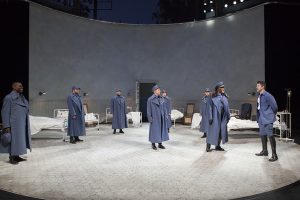
Jonathan Cake in the title role of the Old Globe’s Macbeth gets the work from King Duncan (Jerome Preston Bates) on Arnulfo Maldonado’s set. Jim Cox Photo
A major and controversial issue with The Old Globe’s 2016 Summer Shakespeare Festival selection were the comedic sequences added into William Shakespeare’s tragedy. Jonathan Cake and Marsha Stephanie Blake tried too hard to be funny as the Scottish Thane of Glamis and his cunning wife. Too many instances of excessive attempts at humor lessened the intensity of the Bard’s dramatic show.
Peerless Another tale involving The Scottish Play. Most of the problems of Moxie Theatre’s regional premiere were in Jiehae Park’s script inspired by Shakespeare’s epic drama. Her over-extended and gratuitously stylish dialogue took too much attention away from a fully committed ensemble and behind-the-scenes team.
Westfield Horton Plaza Parking Without any warning, free three-hour parking was no longer made available at the Downtown San Diego mall. Instead, San Diegans have to now pay significantly more money for parking after 60 minutes and can only get validation at a select few locations. This change caused a great deal of annoyance towards the end of the wonderful 2016 San Diego International Fringe Festival. What still remains frustrating is a lack of explanation for the new hourly rates at the Westfield parking lot. On the plus side, San Diego Repertory Theatre is now giving theatregoers parking vouchers at 225 Broadway.
Martin Jones Westlin
Bravos
Let’s Bring Back Rep’s ‘Disgraced’ Every Day. While lots of 2016 San Diego theatre presentations qualified for praise, one was absolutely in a class by itself, its colossal production values matched measure for measure by its daunting perspective on Islam’s relationship with the West. In another world, my kudos this year would take care of themselves — because if I had my way, I’d run my retrospective on San Diego Repertory Theatre’s Disgraced five times and be done with it.
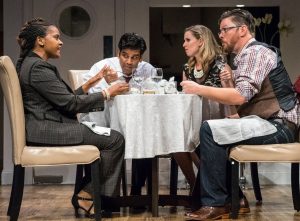
Jory, Amir, Emily and Isaac (from left, Monique Gaffney, Ronobir Lahiri, Allison Spratt Pearce and Richard Baird) didn’t exactly enjoy their time together over fennel salad and booze — the looks on their faces suggested the brutality behind what’s to follow. Photo by Daren Scott.
This production from last fall was nothing short of a miracle for the ages.
Ayad Akhtar’s immaculate play won the 2013 Pulitzer Prize for drama, and director Michael Arabian and assistant Ralph Gregory Hurst immediately capitalized on the script’s bigger picture. Ronobir Lahiri, M. Keala Milles Jr., Monique Gaffney, Richard Baird and Allison Spratt Pearce were exceptionally cast in a superb illustration of Islam’s personal sway and cross-purposes in the current Western experience.
I’ve written something like 1,400 reviews over more than 20 years — and if this show isn’t in my all-time top 10, then no such top 10 exists.
‘Seven Spots’: InnerMission Is All Grown Up. If you like the more stylized approaches to stories about the very un-stylized spoils of war, then InnerMission Productions’ Seven Spots on the Sun was for you. Director Carla Nell painted a gritty kaleidoscope of movement and vocalisms last fall as she gave witness to civil conflict in South America — the characters in fictional San Isidro and a nearby village are united by a plague that affects children, and only reclusive town doctor Moises seems able to fix it. As pilgrims flood San Isidro in search of his cure, Moises is forced to confront his past and the town’s devastation.
A couple scenes in Martin Zimmerman’s play include a radio that’s gone haywire and can’t haul in a transmission; the idea is that solar activity is behind the incredible static. Indeed, electrical storms interrupt our commerce the same way war upends lives; this production drew the parallels handsomely and with a much greater than average depth of understanding. With this show, little Innermission fueled some pretty damn big ideas.
Life Imitates ‘Art’ As Intrepid Comes of Age. The real star of Art, Intrepid Theatre Company’s inaugural Horton Grand Theatre show, was a 5-by-4 painting that does more than decorate a living-room wall. It almost ends relationships among a trio of longtime friends over flaps that have nothing to do with the artwork itself. But that’s what’s cool about Yasmina Reza’s play, staged last October. Subjective conclusions, she says, only lay the foundation for our friendships and our fears.
Daren Scott’s braying Marc, Jason Heil’s swooning Serge and Jacob Bruce’s button-down Yvan all fueled a highly ensemble look and feel and a seasoned give-and-take. Christy Yael-Cox responded with a veteran’s cache of tools, painstakingly layering the compatibility of each set of speeches. This was a very nice entry from a hardworking company, one that will stay fresh in our minds as we anticipate the troupe’s next mount.
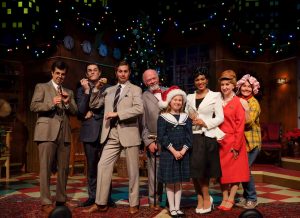
Susan Walker (Julia Van Skike, center) will come to believe in Santa (Jim Chovick, to her immediate right) in a most unexpected turn of events. Photo by Ken Jacques.
You Missed ‘Miracle on 34th Street’ By That Much! It closed Dec. 23, and it’s unabashedly niche in its story — but pieces about the suspension of disbelief are never out of season. So it was with San Diego Musical Theatre’s Miracle on 34th Street: A Live Musical Radio Play, the company’s debut at downtown’s Horton Grand Theatre and a perfectly wonderful look at the universal reward amid a little girl’s change of heart.
The remarkable thing about this piece is that it manages not to take sides. Even the historic Macy’s-Gimbels department store feud is upheld in its lightness of being. Add the lush holiday set and director Colleen Kollar Smith’s sense of fun; you had a cast whose composite feel was as big as the holiday itself.
Here’s hoping this one becomes an SDMT holiday tradition. No reason on Earth it couldn’t.
fruitlessmoon’s Powerful ‘Godot’ Rocked the Sun. Estragon’s left lung is pretty weak. By contrast, his right side is clear as a bell. No telling how he knows that, since he’s probably never seen a doctor. But that’s part of the point with Waiting for Godot, which fruitlessmoon theatreworks staged for us last spring. Life’s only certainty is uncertainty, playwright Samuel Beckett seems to say — and director Aimee Greenberg thoroughly gets the corollary (i.e., the absurdity of hope).
Boos
‘The Sound of Music’ Just Plain Doesn’t Work — Ever! Just because something’s called a classic doesn’t mean everybody deserves credit for making it one. In the case of The Sound of Music, presented by Broadway San Diego last fall, the main culprit is Oscar Hammerstein II, whose breathtakingly lame dialogue ruins an already threadbare story about the von Trapp family and their escape from 1938 Austria just as the Nazis invade.
Jack O’Brien’s helmsmanship didn’t help; the Tony winner and former Old Globe Theatre artistic director was off and running with his ideas for stage pictures and action, never stopping to take a breath and gain perspective on who’s doing what when.
Straight out of the gate, and as it always does, The Sound of Music had me rooting for the Nazis.

Boone (Richard Johnson, left) and Ethan (Connor Sullivan) state their cases, replete with the appropriate attire, on the sexual orientation of Yankee men.
‘Jesus Hates Me’ and ion: Unholy Alliance. If a Second Coming ever does materialize, you can bet Jesus’ enemies will kill Him as ruthlessly as before, railing at the prospect that their Captive’s divinity is part of us all. Frankly, if that’s not hilarious in its irony, then neither is anything else — which is what was so strange about ion theatre company’s Jesus Hates Me from last spring. What may well be a religious farce somehow morphed into a dour, humorless treatise on man’s inherent evil, intent on seeing the world as an irrevocably dark outpost in a formless sea.
Wayne Lemon’s play has plenty of possibilities for the humor in it. All were played inexorably straight, as if director Glenn Paris was seeking every excuse to justify his harbinger’s approach. Wholesale misdirection was afoot here as this show went for theatrical effect at the expense of theatrical truth.
Broadway SD’s ‘Book of Mormon’ Hadn’t a Prayer. Don’t draw any conclusions from the fact that my first three boos revolve around religion. Religion as a social and supernatural concept is a noble — nay, vital — enterprise in the course of human affairs; it’s just that that makes it ripe for dissection on the public stage. The Book of Mormon, with its nine Tony Awards and its regular national tours, has found itself the object of such attention in several cities, including this one.
With its local installment came an indelible lesson on mortal sin.
The problem is that the acting and directing drown in their own silliness before any of the writers (chiefly South Park‘s Matt Stone and Trey Parker) bother to focus on the tenets of the faith. So giddy. So over the top. So unmindful of the reference points that give the humor its life. For every Tony this piece won, it lost far more in its miserable efforts at stagecraft.
It’s a laff riot that masquerades as an artistic construct, whose audiences already know something about hell by virtue of their attendance.
‘Gutenberg! The Musical!’ Wasn’t Worth the Ink. In God’s name, what possessed Backyard Rennaisance Theatre Company to take on this absolutely dreadful piece, which ruined everybody’s August? The company principals are among the finest local talents you’ll find; difficult to fathom how they decided to tackle it, much less that they did. This is one of the dumbest, most self-indulgent Broadway-centric tales out there, with its literary and musical elements woefully out of balance — in a parallel universe, it wouldn’t have closed on Broadway so much as closed Broadway down.
Tom Zohar and Anthony Methvin played all 30 roles and sang all the songs before the hitmakers, and something was surely said for the performers’ abilities as each other’s foils.
But writers Anthony King and Scott Brown and director Kim Strassburger simply didn’t know when to quit, crafting a cavalier approach to Gutenberg’s work that trivializes his invention in the first place and, worse, literally guiding us through the hows and whys of their play while leaving nothing to our imaginations. Theater was suspended in a sea of gimmickry that may well have set the printing industry itself back to Gutenberg’s day.
What a mess.
Cygnet’s ‘Rain’ Buried Its Story in the Mud. Man’s earthly demise rarely needs to bellow its approach through a theatrical foghorn; the smaller the voice, the more effective — and the more keenly heeded — the warning. The former’s colossal scale was the problem with the otherwise smart When the Rain Stops Falling, Cygnet Theatre Company’s show from last winter.
Andrew Bovell’s thick-as-a-brick script introduced everything from missing kids to suicide to skyborne miracles to fish soup in explaining a grisly father-son relationship, In so doing, he’d irrevocably buried his case amid its gross overstatement.
Decades of interconnected stories describe the circumstances around young Henry Law’s disappearance and the fortunes of two families 80 years and half a world apart. Interminable rainstorms punctuate the tales, with director Rob Lutfy having told them through some arresting stage pictures. Sadly, he was forced to compete with Bovell’s earth-crushing obsession with every single detail as the show’s technical prowess eventually upstages the story. The result was a hodgepodge of the same-old same-old, whose crescendo neither inspired nor enlightened.
Welton Jones
After 60 years of writing reviews, I tend to, well, pace myself. Some call it “cherry-picking” but I suggest that my aged perceptions are best used on the art with the loftiest expectations while aspirants are better considered by a fresher generation of observers.
In other words, I prefer the established pros to the ambitious strivers, in most cases. Please understand, my respect for and support of anybody who works to create art is intact. I just choose to use whatever energy I retain on the highest likely quality available.
So what I write most about now are the shows at the Old Globe Theatre and the La Jolla Playhouse plus the occasional touring production. This contents me and keeps me at a certain level of keenness.
(I do make an exception for the annual summer Fringe Festival, an overdose of potpourri that I find hard to resist for sheer whacky surprises. And I do sneak into other theatres now and then, which is why I was privileged to catch one of the season’s very best pocket musicals, Justin Huertas’ tour de force Lizard Boy The Musical, at Diversionary Theatre. It defies description in a tight paragraph but remember that name. And maybe that title, too.)
I glow with pride at the quality and quantity of the San Diego theatre environment today, an awesome advance from what I doggedly chronicled in days of yore. A dozen managements maintain loyal followings by demanding improvement of themselves. It may not be a golden era in theatrical history elsewhere but neither our artists nor our audiences have heard that word. We’re too distracted by the rich menu.
So. Between them, the Globe and the LJP brought forth about 17 top-of-the-line shows in 2016, not counting the developmental projects, the student work and so forth. I was there for them all and I’ve pondered what sort of lookback would be of the most interest.
Lists are fun. And, after decades of doing this stuff, I am blithely fearless at comparing goldfish to chainsaws. The only question is whether to start ranking them at the bottom or the top.
Oh, let’s do the dirty work first.
- The Lion, OG – Benjamin Scheuer and his seven guitars described a life of blues music, cancer and acute self-awareness with elaborate fingering.
- Guards of the Taj, LJP – Rajiv Joseph’s unappetizing blend of Waiting for Godot and Grand Guignol in a wispy India. Dogged acting counts only so far.
- Rain, OG – Why Sybille Pearson felt it worthwhile to adapt W. Somerset Maugham’s steamy novella of tropic temptation remains unknown. Is there a clue in the realization that gender politics are made to out-gun ole time religion? Michael John Lachiusa’s music is of little help in a crowded staging with no sense of place.
- The Last Tiger in Haiti, LJP – Jeff Augustine’s lyrical and urgent tale of child slavery also floated free of locale, blurred by dialogue in accents probably accurate but largely incomprehensible.
- The Last Match, OG – Anna Ziegler’s tennis drama, with a lot of off-court tension, was memorable mainly for Gaye Taylor Upchurch’s clever staging in the arena of the White Theatre. No rackets, no nets and no balls!
- Camp David, OG – Three guys sitting around talking sounds unpromising. But the 1979 agreement between Anwar Sadat, Menachem Begin and Jimmy Carter, as author Lawrence Wright triumphantly concludes, has resulted in no wars between Egypt and Israel for over 30 years. Serene and stately staging by Molly Smith.
- tokyo fish story, OG – A sushi saga served as a metaphor of pride in achievement. As author Kimber Lee’s modest play points out, one must do what one can with what one has. Director May Adrales and her designer colleagues somehow made the White Theatre arena work as a believable kitchen with nothing that spills.
- Macbeth, OG – Brian Kulick set the tragedy as a military fantasy in a frozen banana republic. Some of it worked quite well, all of it rang with intensity.
-
Sense and Sensibility, OG – As he did five years ago at the Globe with Emma, Paul Gordon led Jane Austen once more into the groves of musical theatre, again keeping the characters sorted out and this time even finding a hit song from a chance phrase, “On the Wrong Side of Five and Thirty.” Director Barbara Gaines made good use of a splendid acting ensemble and bright, cheerful décor (even the neon touches) and the music was played by an acoustic ensemble of 10.
- Tiger Style, LJP – Magic realism went goofy as a pair of ultra-achiever siblings slipped their harnesses and followed the lure of their Chinese heritage into an ugly reality of alienation where they don’t even speak the language. Mike Lew is a playwright to keep in view. And he, in turn, should stay in contact with director Jaime Castaneda, who gets the style.
- Love’s Labour’s Lost, OG – John Lee Beatty successfully sucked significant foliage from the surrounding Balboa Park onto the outdoor Lowell Davies Theatre stage for this most artificial of Shakespeare’s comedies. Broadway vet Kathleen Marshall found great seats at the table for such actors as Stephen Spinella, Triney Sandoval and Kevin Cahoon. A dream.
- Hollywood, LJP – Joe DiPietro found a fascinating connection between the silent-movie era scandals and the risen of censorship and Christopher Ashley turned it into a moody stimulant.
- October Sky, OG – Based on the true story of Homer Hickam, who somehow pulled himself out of the West Virginia coal mines and into space exploration, the Brian Hill-Aaron Thielen-Michael Mahler musical suffered from over-cooking but still made for dandy and rousing theatre with definite commercial possibilities. Director Rachael Rockwell even managed to make some sense of the looping, preachy book.
- The Metromaniacs, OG – David Ives admits that he kept little of Alexis Piron’s 1738 comedy (“a comedy with five plots, none of them important…”) except the title. It’s ersatz Moliere with a shameless abandon and it gave acclaimed director Michael Kahn a chance to revive nearly every gag I can think of while inventing new ones like “the fishlips of passion…” The cast, mostly vets of an earlier Washington, D.C., production, helped the audience enjoy it almost as much as they themselves did.
- Miss You Like Hell, LJP – Almost a terrific musical with words by Quiara Alegria Hudes and music by Erin McKeown. It’s a classic road story and super Americano in all our glitz and glory. (Personally, the show helped get me through the last days before the presidential election. Thereafter, I and they and all of us are on our own.)
- Meteor Shower, OG – Steve Martin’s surreal sitcom of two couples star-gazing and wrangling through a long California evening grows and expands in the memory. Gordon Edelstein’s staging is just fine but this is a play that needs to be seen in various versions.
- Junk: The Golden Age of Debt, LJP – It took Ayad Akhtar’s polished drama to help me finally understand such economic basics as “debt can be an asset” and why “high-yield bonds” is sarcasm. Doug Hughes directed a superb cast that seemed to be playing a thriller.
A splendid season, this. And not a one of them a recreation of a recent Broadway hit. That’s how much the American theatre has changed in 60 years: Where once shows flowed outwards from Broadway, the current flows now in the opposite direction.
A couple of trends I noticed this year:
-
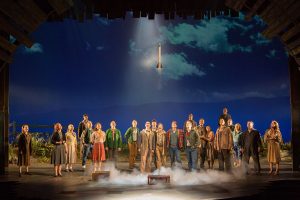
The community of Coalwood, W. Va., enters the Space Race in October Sky, at the the Old Globe Theatre. Jim Cox Photo
Visual projections are very important to the future of the art. I direct your recollection to Hollywood, for which Tara Knight mixed old film clips and headlines; to Peter Nigrini and Dan Scully’s décor domination in If/Then touring at the Civic Theatre; and, most of all, to the vast and living West Virginia landscapes evoked in October Sky by Shawn Sagady.
- And sound counts too, as with Ken Travis’ thunder in the Rain and Bray Poor’s tennis crowd noises in The Last Match, both at the Globe.
The Fringe? Ah, yes. Though I saw only a handful of the 90 shows scheduled, it was enough to scratch my itch. And my favorites were easy to pick, from opposite ends of the professional-polish spectrum: Bella Culpa, by the classic clown/acrobat duo of Amica Hunter and David Cantor, and The Phantom of the Empire, a mash up of Broadway’s favorite spook and the Star Wars saga, with a voice-removed Andrew Lloyd Webber tape and a dozen-plus post-grad pals doing everything else. I’d walk a mile to see either one of those shows, right now!

In addition to reviewing theatre for San Diego Story, Bill also reviews for TalkinBroadway.com. He is a member of the San Diego Theatre Critics Circle and the American Theatre Critics Association. Bill is an emeritus professor in the School of Journalism and Media Studies at San Diego State University.

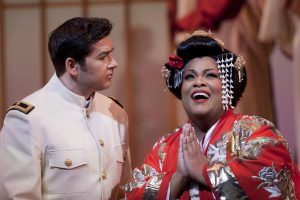
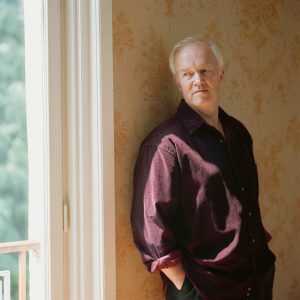
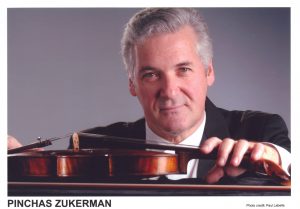
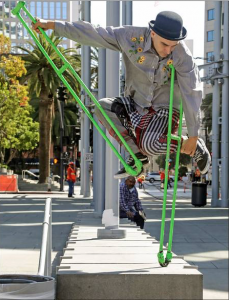




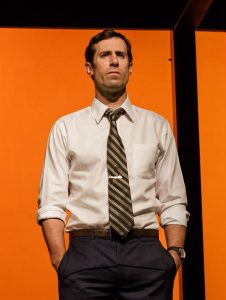
This list is a disgrace. Try building up your local musical and theatrical community instead of tearing it down. I expect better from this publication in 2017.
I think this is sort of wretched. I don’t understand what you folks are doing or accomplishing by dragging folks a second time. Your job, as critics, is not just to given your opinion as if you’re cultural arbiters. You’re given a position to evaluate artistic work and advise the public on entertainment options. It is not just about you having a space to say what you think is good or bad.
A celebration of the theatre season would be fantastic, but I am unsure what inherent value there is in discussing what you dislike. Again. It’s self-aggrandizement. Then you just harp on a style of theatre, the “pop-up” style because it’s inconvenient. You’re professional theatre critics. Do your jobs. Critique the work, move on. This is just reprehensible.
Graham and Tom –
First and foremost: Thank YOU! for taking the time to comment. We really REALLY appreciate hearing from you. And I can guarantee that everyone on the staff will consider your remarks and count them as representative of more readers than just the two of you. “Bravo” from me for your contribution.
That important piece said, I must now say it fascinates me that you both appear to wish for lauds and honors for all. That “celebrating the theater” and “building up…the community” can mean only praise – and visited only once. Should the critics follow your tone and direction, we could no longer call them Critics, but – possibly – professional Sycophants? And, overall, the Bravos appear to outnumber the Boos…
First, I believe this piece is a rare celebration of the arts community by its very existence, representing hours and hours of effort over a year. The best way to kill something is to ignore it. Despite working on their own time, this crew conducts itself as if each piece were their primary occupation. Feedback to Arts management about the impact of their operations is an important part of the conversation.
Second, I believe few of the arts management teams in town will read a praising review and do anything differently. I trust they feel a sense of accomplishment and satisfaction and that’s a good thing. However, a negative review or even negative comments embedded in an overall positive review I trust inspire inspection, review, consideration and act as a contribution to the overall artistic process.
Lastly, regarding revisiting and “moving on”: a year of San Diego’s rich Professional Performing and Exhibition Arts seems a fitting celebration of it, lest it fade away unnoticed. Choosing not to wake in a brand new world everyday permits learning and growth and reflection. It’s not only an overall contribution for Critics of the Arts to look at their work again and provide that review, it serves as an important and formative study of their own art in reviewing shows and setting 2017’s efforts in context.
Again, thanks so much for your comments. Keep ’em coming!
Mark S. Burgess
Publisher, sandiegostory.com
Managing Partner, Critics LLC
Dear Mark,
In my comment I never said that you should sacrifice your credibility at the altar of praise. What this article does, however, is posit the critics opinions as worthy of a year-in-review. I don’t have an issue with bad reviews, I have an issue with the need to bring up creative work that you’ve already given your opinion on in order to give it a second bad review. That serves no purpose.
You say “the best way to kill something is to ignore it.” Fine. That’s a pretty pat sentiment, but you’re not ignoring it. I imagine you’ve been reviewing shows all year long. There’s nothing to be gained or learned from repeating the critiques and creating a Worst Of list.
Look: I’m not a San Diego actor. I’ve done three shows in the city during my professional life. I’m not having a go at you for the sake of it, but I think you’re over-estimating the impact your reviews have on arts administrators. They like good reviews, sure. It makes a nice quote. And a universal pan doesn’t help them any, but I am fool proof, 100% positive no artistic season, execution, or decision is made in response or in hopes of a critical analysis.
I enjoy criticism when I think it is fairly applied, but as an artist, if you think about working to please another’s voice or taste your work is already dead and limp.
So why does this list exist? If it’s a celebration of the theatre community, reminding folks of failures, through your perception or not, only serves to place the writer as the formost arbiter of taste. That is not to the best of my knowledge your job. Lastly you say this article provides your critics to review their own art which… I’m gonna be honest here, man…
doesn’t make a lick of sense.
You wanna analyze your own work? Cool. That doesn’t make your analysis worthy of publishing.
That’s very curious to me. I have never personally viewed published art critique (positive or negative) to hold any place in the artistic process. It is an entity of its own, separate from the creative endeavor.
Tom and Charles
““A truly great book should be read in youth, again in maturity and once more in old age, as a fine building should be seen by morning light, at noon and by moonlight.”
― Robertson Davies
Seems a worthy exercise to both reader and writer to go through the year’s reviews and organize them as a whole. A reader who attends a performance and then reads a review brings a different perspective to the reading than one who reads it and then attends. So it is when looking back over the year’s reviews for both reader and writer.
Maybe I’m missing something in what everyone perceives as the role of the art critic. A critic’s role in my view is not to be the live theater version of TV guide, giving a precis of the plot so as to assist in distinguishing episodes. True, the profession appears to have receded in its power to close or extend a show by its impact, but that seems to me to be a darkness to rage against.
And, there’s no intention to corrupt but to assist the artistic process with educated, clear speaking commentary. The critic isn’t promoting an actor’s career, a venue’s character or any self interest other than to provide an independent point of view in the context of an interest in Art. Management’s who don’t avail themselves of that input seem to me to be inviting a form of myopia.
Mark
Mark, you’re not re-reading the book. You’re just repeating what you had to say about it in the first place. And you’re not posting the full reviews to be re-read, you’re posting snippets to list of what’s best and what’s worse.
No one is asking you to provide a synopsis, no one is asking you to tread lightly. I think I’m seeing this list with a shake of my head and I can only think it’s disrespectful. You wanna have a conversation about theatre, that’s fine. But you are not having a conversation, You’re telling people “my voice is most important” when you create a list like this.
This comes across through a very paternalistic view as to who should be listening to you. No, your job is not to guide or promote any person or any place, but you are also not an advisor to the senior staff. I’m sorry, brother. You have your job because folks trust your taste, but when you say “[m]anagement who don’t avail themselves to that input seem to me to be inviting a form of myopia” it makes me pause. You have taste, but yours is not superior or to be listened to more closely by the artists’ than their own. None of us, not a single one I’ve encountered in ten years of doing this all over the country, has ever opened a rehearsal and thought about what a critic might say. Your primary engagement is with your readers, you’re their guide.
I would first of all like to extend my sincere apologies to Martin Jones-Westlin for ruining his month of August. It was never my intention to destroy his summer by choosing to perform in an irreverent crowd-pleasing little comedy show he hated with every marrow of his being. Should I send a fruit basket? Please respond to me at your earliest convenience and we will arrange a way for me to atone for the unintended murder of the eighth month of the year.
Joking aside, one wonders who Tom Methvin is. It would appear I performed with him but somehow I can’t recall anyone I know by that name. Weird. Anyway, I personally don’t see the point in a “here’s everything we hated last year!” list, as I find it needlessly, pointlessly negative and unproductive, but then again I also think Book of Mormon is a brilliant show and I absolutely loved When the Rain Stops Falling, so I guess we will all have to agree to disagree!
Best,
Tom Zohar
AKA Destroyer of August
This article reeks of tabloid op-ed journalism and lacks any constructive critiques or praise to be taken seriously. The overly dramatic lamentations are tawdry. Remarks that a stage play is “a mess” is neither funny nor helpful to a would be theatre goer. It seems that the true divas are in the newsroom and not on the stage. I seriously doubt an article laced with mistakes can help the arts in San Diego but based on your comments that’s obviously the intention.
Um, okay… I don’t know who signed off on some of this…but you couldn’t get twenty people to agree to these assessments of Rain nor Gutenberg. Rain was beautifully acted, directed and designed. It was inventive, moving and original. Frankly, I only wish I could have been a part of it. And as for Gutenberg I haven’t laughed, really laughed that hard in a long time. And I know people who went back multiple times. It is not high-art…that is sort of the point. Read the program. It is a parody. It is satire and ANTHONY (not Tom) Methvin and Tom Zohar were seamless in their comic timing and craft. Again, show me twenty people who agree with this assessment. I take ALL reviews with a grain of salt. The onus is on the theatre goer to review, critique and share their opinions with kindness and civility. I am sad that the strong negative opinions expressed here are lacking both.
So sorry that I didn’t catch the mistake in identifying Anthony before we posted. It has been fixed now, along with a couple of other typos and errors..
Just for the record, I enjoyed Gutenberg.
Bill
To be clear I am referencing When the Rain Stops Falling at Cygnet.
Hannah, I also enjoyed “When the Rain Stops Falling” and was happy that it was nominated for Outstanding Ensemble and for Rob Lufty’s direction.
To All,
Personally, I love this! Critics of the critics. I trust the writers above taking a negative view of our year end summary (with the embedded links to each review mentioned) do not consider yourselves the last and final revered word anymore than any of our writers do.
When we first started the site our motivation was not at all to position ourselves above anyone but to try to be a voice in an ever diminishing chorus of reviewers. To help stimulate the conversation that promotes the Arts. Among our contacts were artists not be being covered anywhere else in ways they could repeat in grant applications requiring it. Since we started, almost all of the full time arts reviewers in town are gone, with only part time and freelancers filling the gap.
We don’t countenance unprofessional or axes to grind or trivial treatments. Every piece we publish is by an experienced reviewer and a lover the Arts rendering an educated and honest opinion.
We believe in the conversation. We offer up how we experience a show and hope someone will notice and continue the conversation. Who knew what some of you thought until you had written above? Most of the reviews to which you have taken exception to our views don’t have any comments on them. I”m so glad you offer them now.
Please, in the coming year, if you see a show we’ve written about and don’t agree with our views, punch us hard in a comment with your reasons and background as to how we missed it. I read every review we publish and every comment and learn a lot. Sometimes I agree with our writer and sometimes I don’t, but over time I’ve developed new ways to take in a performance and a greater appreciation for the artists and what it takes to present these works.
Mark
Boos have no place in the theatre. Save the boo for the ballpark. Have some respect for the artist and for the theatre. Class is sorely missing in this attempt at opinion.
Don’t change a thing.
As initially disgusted as I was with the format of this year-in-review article (I’m in the “you-already-spat-on-it-once-so-what-good-will-a-second-do?” camp), I wonder if it has not potentially helped to crystalize what has long been lacking in most of the theatre criticism in San Diego, on both sides.
What I’m hearing repeated through the comments left by those in the theatre community is that negative reviews are not unwelcome. What is unwelcome are:
A) Negative reviews that fail to offer specific support or evidence or explanation of the negative criticism
and
B) Negative reviews where the criticism is delivered in aggressive, snarky, irreverent rhetoric.
The former raises frustrations in the community because they offer no context or means to understand why a choice or performance or production is being criticized, and so nothing could be learned from the review, even if the reader were inclined to take it into consideration. Taste is not a just basis for criticism. It is a legitimate reason to not like something, but not reason enough for a reviewer to label something unworthy.
The latter raises hackles because, frankly, it’s just plain rude. Perhaps it’s Pollyanna of me, but tact and respect and civility matter. As has been pointed out several times, no one – not those who do it, or those who write about it – get paid enough (if at all) for however they contribute. Making theatre is an enormous commitment of time and resources. The vast majority of theatre makers in San Diego (excluding the Globe and the Playhouse here) work second and third jobs in order to be able to afford to do the work they love. I know a few people who have taken second mortgages on their homes in order to keep some of the smaller companies afloat. So when a production that is a culmination of the multiple sacrifices and efforts and energies required to make it happen at all – let alone happen successfully – is ridiculed with the vehemence that some of the critics on this site use, it cuts deep and it cuts true, and it is no small wonder that defensiveness and anger lead very quickly to disregard on the theatre-makers part.
I, for one, am encouraged to see that you, Mark, are so welcoming of this sort of feedback. I’m thrilled that you are welcoming of this conversation, and grateful to those who initially commented for breaking it open. You’ve tasked us with continuing the discourse through the next year. Good. Thank you for reminding us of our responsibility in creating an Arts Community that is engaged and involved and beneficial to all parties involved. But meet us half way. Task your critics with living up to the objectives and purposes you posit for this site: fostering educated, thoughtful, respectful analysis of what we produce, for everyone’s benefit. If a reviewer doesn’t like something, task them with including specific reasons why. If a reviews loves something, included specific reasons why. And do so respectfully.
No one does this because it’s easy, and if it were easy to do well, there would be no need for critics at all. I can’t imagine critics do what they do because they don’t love it – your own comments have convinced me of that – so listen and hear what the community that does the work you love wants from you, and hold yourselves to the same standards you hold us to.
First off, thanks for taking the time to review our local theatre community. I appreciate what this publication has done to raise awareness of San Diego theatre.
I want to second Rachel V here. She has put into words what I found troubling about the “boos” section of this article. Constructive criticism is always welcome, while unsubstantiated and/or disrespectful critique is hurtful and unproductive. Additionally, I agree that it feels unnecessary to negatively review a show more than once by including it on this type of “boos” list.
Speaking for myself, a good rule of thumb for writing a review is “would I be comfortable saying this to the person’s face?” For example, saying someone’s show is a “mess” would not pass that test for me, personally.
Again, thanks for this. Although I disagree on some of these points I appreciate San Diego Story’s work as a whole.
Rachel
Assignment accepted. Thank you for your thoughts.
After a short couple of audition articles, everyone writing on this site publishes directly. We don’t make an editorial pass first, so the other principals and I see the pieces they and the other writers post at the same time you do.
I’ll refresh a watch for reviews containing, and comments that point out, the unsubstantiated. As for guarding against snarky, that’s a bit more difficult to measure and even more difficult to coach – one’s snarky is another’s piercing commentary and we purposely avoid much direct censure. In fact, I’ve lost arguments to publish some quality work that the writer feared would bring too strong a reaction. But, I agree and will watch for snarky AND unsupported which sounds like the one-two you object to the most.
Mark
Don’t ditch the erudite and snarky, please.
The very intention of “SanDiegoStory” is: Sandiegostory is a vibrant forum on live performance in San Diego County. Sparked by reflections from seasoned critics in theater, music, dance, and performance art, the site invites discussion on the arts and their meaning in our lives.
I think the comments posted on this year’s Bravos and Boos proves our mission!